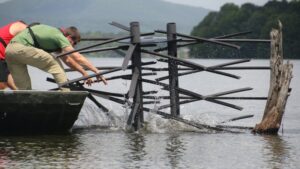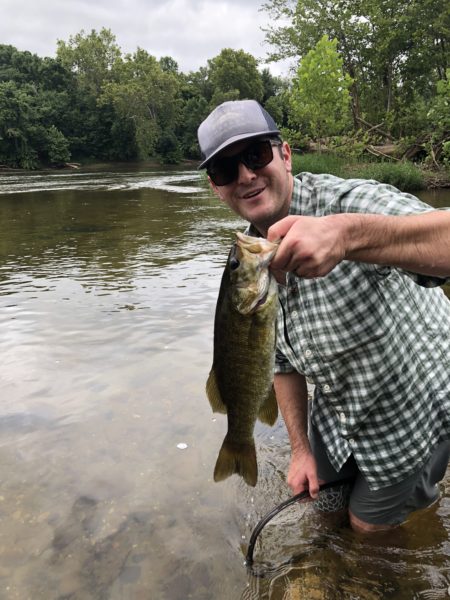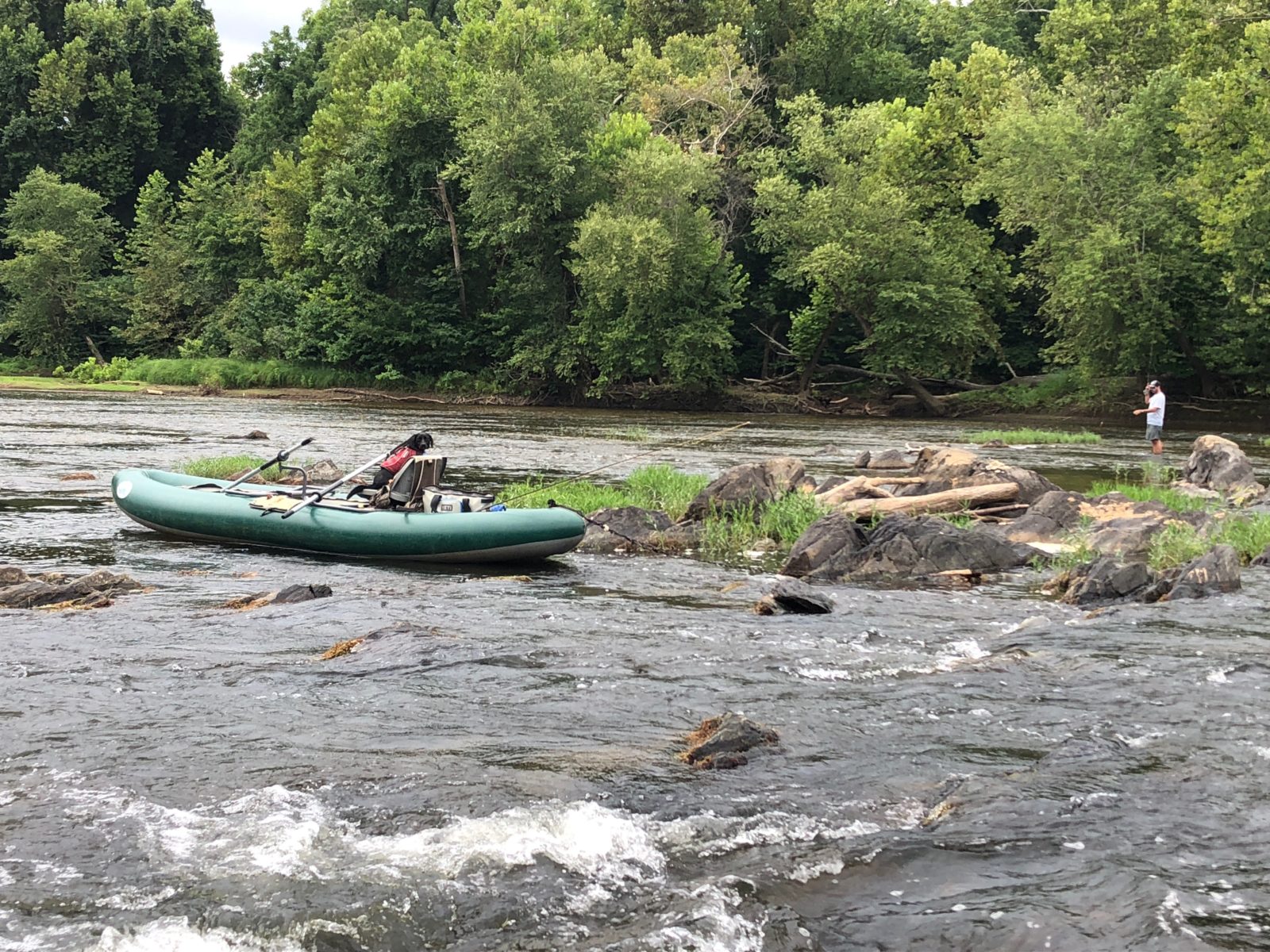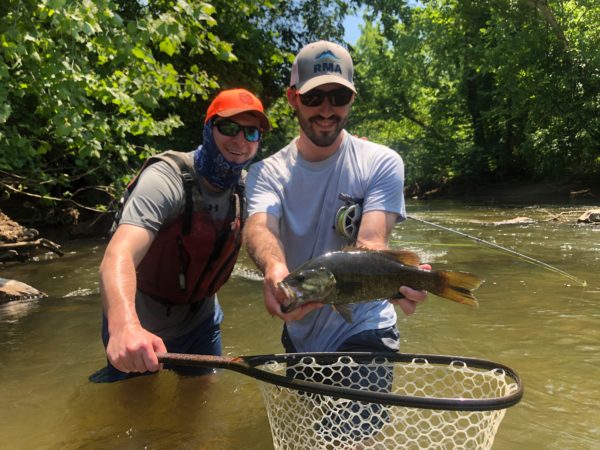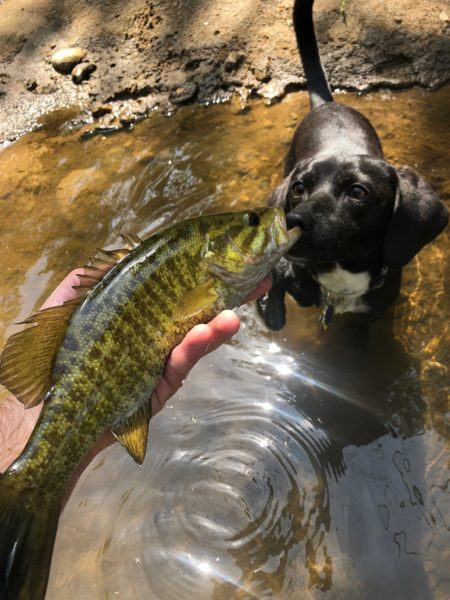Tipf for Pacific Salmon Fishing in Lake Ontario Tributaries
Editor’s Note: Here’s a great guide to the run of jumbo salmon now entering the rivers of New York from Lake Ontario, from the New York State Department of Environmental Conservation.
from The Fishing Wire
The two species of Pacific Salmon found in Lake Ontario are the Chinook and coho salmon. Chinook salmon grow larger and are more heavily stocked then the coho, with approximately 1.7 million Chinook salmon and 250,000 coho salmon stocked annually in Lake Ontario and its tributaries by New York State. When salmon return to these tributaries in two to three years as adults, they weigh 8 to 30 pounds and offer a unique and exciting fishing experience.
Typically, the tributary fishing for Chinook and coho salmon begins in early-September and runs through early-November, with the peak often occurring during the first two weeks of October. Having success with these hard fighting fish requires using the right gear, flies, baits, lures and then presenting them in the most effective manner. Safety is also a concern when heading to these waters as most of them are large and can be difficult to wade in. Each of these topics will be discussed in more detail below to help get you started chasing these hard fighting fish.
Where to Go
Some of the more popular salmon fishing tributaries are:
Black River (PDF) (511 KB)
South Sandy Creek (PDF) (592 KB)
Salmon River
Oswego River
Sterling Creek
Genesee River (PDF) (601 KB)
Sandy Creek (PDF) (661 KB)
Oak Orchard Creek (PDF) (485 KB)
Eighteen Mile Creek
Lower Niagara River
Coho and Chinook Salmon
Coho and Chinook salmon are spawned at the Salmon River Hatchery during the month of October. The eggs hatch out in late November through December. Chinooks are stocked as 3 inch fingerlings in May or June. Besides shore stocking, some of the salmon are also pen stocked. Pen stocking is a cooperative effort between the NYSDEC and area sportsman groups. Pen stocking allows recently stocked fish a chance to acclimate to their new surroundings and offers some protection from predators. Fish and feed are provided from the NYSDEC Salmon River Fish Hatchery while the sportsmen’s groups build and maintain the pens and feed and take care of the fish for approximately 3 weeks. The fish are subsequently released into the stream or bay. This pen stocking program has been very successful. Shortly after stocking, salmon “smolt” imprint on the scent of the stream before migrating downstream to the lake. Coho are stocked as either pre-smolt fall fingerlings at 10 months of age (4½ inches long) or as 6 inch yearlings at 16 months of age. The life history of the coho salmon requires that they stay in the streams for at least one year before moving down to the lake. Once they reach the lake, salmon grow rapidly on a diet of alewives. Chinook salmon returning to the rivers where they were stocked range in age from 1 to 4 years. Age 2 and 3 fish make up 90% of the run and will weigh between 15-25 pounds. Mature coho salmon return to spawn as age 2 fish and will average 8-10 pounds.
Maturing Pacific salmon begin to “stage” off the river mouths from mid-to-late August. By early September some fish have usually started to trickle into the tributaries. The peak of the run when the best stream fishing occurs is actually a rather short 4 week period. On rivers whose flows are controlled by hydropower dams, such as the Salmon and Oswego, this peak period normally occurs from mid-September through mid-October. On other salmon streams across the state the timing of the runs is more dependent on rainfall. Generally salmon will enter these streams somewhat later with the peak occurring in mid-October. Once Chinook and coho salmon enter the streams, they are no longer feeding. Their bodies are undergoing rapid physiological changes and their sole purpose left in life is to spawn. While they are not actively feeding, they do exhibit several behaviors which make them vulnerable to traditional sport fishing techniques. One of these behaviors is aggression or territoriality, and another is their attraction to fish eggs or egg shaped lures.
Equipment
Fly Fishing
Fly rods of 9-10 feet long for line weights of 7, 8, or 9 work well for salmon. Reels with a smooth disc drag are recommended to stop runs and tire the fish. Reels should have large enough capacity to hold at least 150 yards of 20 pound test backing. The backing should be fluorescent colored so you can see where the fish is running and so other anglers can see you have a fish on. Full floating lines are best as they allow better line control. Leaders are normally in the 8-12 foot range. For the butt section use a 6-8 foot section of 10-15 pound test line. At the end of this attach a small black barrel swivel. This serves as an attachment point for the tippet section and a dropper for split shot. The tippet section should be 2-3 feet of 6-10 pound test, depending on conditions.
Spin Fishing
A medium or medium heavy action graphite rod 8-9 feet long will allow you to keep line off the water, detect the strikes and play the large fish effectively. Reels should have a smooth drag and the line capacity of at least 200 yards of 12-15 pound test line. A 2-3 foot leader of 8-12 pound test line is also recommended though not required. Using a leader will save you some tackle and time. The leader being a lighter pound test will break, theoretically, before your main line when snagged. That way you only lose your fly or bait and save your weight
Effective Flies and Baits
Flies
Three basic types of flies are used to catch Pacific salmon when they are in the rivers. These are egg imitations, wet fly/streamers, and stonefly/nymphs. Tie your flies with materials that have a lot of action, color, and flash to attract a salmon’s attention and aggravate it into striking. Larger size flies work better earlier in the run in the lower sections of the river. Switch to smaller sizes when fishing for salmon that have been in the river for several days or in the upper areas. Heavy fishing pressure or low clear water would also call for smaller flies and lighter leaders. Use patterns that are quick and simple to tie because you will be losing a lot during a day’s fishing both on the bottom and fish that break off. Fly fishing is one of the most successful methods of catching Pacific salmon because of the unlimited combinations of colors, shapes, and sizes that can be created in the fly.
Some wet fly/streamers patterns to try are: Wooly Buggers hook sizes #2-8 in black, olive, purple, chartreuse, flame or orange; Mickey Finn sizes #2-8; black bear green butt sizes #4-10; comet style flies sizes #2-10; and marabou streamers in various hot colors. Good egg imitations are glo-bugs or estaz eggs hook sizes #6-8 in chartreuse, flame, orange or hot pink. Both work well and are quick and easy to tie. You can also try stonefly/nymphs size #4-10. Carry some tied with hot colored flashy materials like estaz and krystal flash, as well as more natural colors like black and brown.
Eggs
Salmon eggs are one of the top producers, and both preserved skein eggs or loose eggs, tied into sacks the size of a dime or nickel with nylon mesh, are fished dead drifted through runs and pools. Artificial eggs come in a wide variety of styles and colors with some being impregnated with scents. Other good egg imitators are 1-2″ twister tails or tube jigs, small pieces of sponge, and plastic beads.
Presentation
Pacific salmon are fish that stay on or near the river bottom as they migrate upstream. You want your bait or lure to pass at eye level to the fish just off the bottom. They generally will not move up in the water column any distance to strike a bait. Salmon often show their presence by porpoising or rolling on the surface of the stream. It is not understood why they do this but they rarely strike when they are surfacing so concentrate on keeping your lure near the bottom. If you fish a large pool, concentrate on either the head or the tail-out. Deep slots or runs along banks, behind logs, or boulders that break the current are other places to try. Another area where salmon seem to strike well is in the upper spawning areas of a river. Once the Chinook and coho have established nests or “redds,” they become very aggressive and territorial. This is especially true of the males which fight each other and drive off young trout or minnows invading their space.
For the greatest success, you want your fly, lure, or bait to be presented in the first 6-18 inches of water off the bottom. To do this properly, you will almost always have to add weight to your line. The secret to success is to use only the minimum amount of weight necessary to keep your bait in that narrow band of water just off the bottom. Too much weight causes your rig to hang up on the bottom, resulting in lost tackle, a loss of sensitivity which limits your ability to sense when a salmon has hit your bait, your rig to drift unnaturally, and will often spook the fish. Not enough weight will cause your lure or bait to float by too high in the water column where it will not interest the salmon. Use removable split-shot sinker and carry at least 3 or 4 different sizes and constantly adjust the amount of weight depending on the type of water you are fishing. As your rig drifts downstream, it should only occasionally tap the bottom. Rarely will salmon smash the fly or bait or strike hard. Often the fish just grabs the fly or bait in its mouth, and your line will simply stop, hesitate, or dart forward slightly. There are two basic methods of presenting a fly, bait, or lure to a salmon. One of these is the “dead-drift” and the other is the “wet-fly swing.” These methods can be used with either fly fishing or spinning tackle.
The Dead-Drift
The basic aspect of this method is getting your fly or bait to drift along as naturally as possible in the current just off the river bottom. You can use egg flies, stoneflies, spawn sacks, or artificial eggs. It is an effective method in pools, runs, or spawning riffles. Position yourself across from, or across and slightly upstream from, where you can see salmon or where you think they are. Move as close to the fish as possible without spooking them. Cast up and across stream at a 45 degree angle. Have just enough weight on your line or leader to get the bait down to be near the bottom 15 inches of water. As your rig drifts back towards you, raise your rod towards the vertical position to minimize the amount of line on the water. When the rig has drifted down to directly opposite your position, your rod should be almost vertical. As the rig passes you, turn your upper body to follow the drift and slowly lower the rod until the line and rig are directly below you. During the drift, concentrate on the point where your line enters the water and feel with the line and rod tip. Watch for any hesitation, upstream movement, or tug on the line. Using as little weight on the line as is necessary and as light a pound test line as possible gives you the best sensitivity to detect the take of a salmon.
The Wet-Fly Swing
This method works best in areas of moderate current speed such as runs or riffles. You can use streamers or wet flies. Position yourself upstream from where you can see the salmon or where you think they are holding. Make your cast directly across or across and slightly upstream. The object is to get your lure to sink until it is just off bottom, drift downstream, and then swing in an arc passing directly in front of the fish at eye level. The streamer imitates a small fish intruding into the salmon’s territory and triggers an aggressive response or territorial defense. This is especially true when the salmon are on a spawning bed. Often it requires many casts, each passing the lure in front of the fish, before it becomes annoyed enough to strike
Fighting and Landing Salmon
After the hook-up, get all your loose line back on the reel as soon as possible. On the first long run, hold the rod tip up, and let the reel’s drag do the work. It should be set tight enough to put some pressure on the fish but not strong enough to break your leader. After the initial run, pressure the fish as much as you can. If the salmon makes a long run downstream, you usually have to follow it and try to get below it. You cannot drag a large fish back up river. The ideal situation is when the fish is running upstream where it will be fighting both the current and your drag. Chinook salmon can be landed by grabbing the narrow area just forward of the tail. With a coho you’ll have to wear a wool glove or the fish will slip out of your grasp. The best situation would be to have a partner stand below the fish with a wide mouth net. Try to be a good sportsman and be courteous to others. If a fellow angler hooks a salmon nearby, be prepared to reel in and step back out of the way.
Safety
Many of the rivers that have Pacific salmon runs can be dangerous to wade in. Rapidly rising water levels, slippery rocks, deep drop-offs, and strong currents are all things the angler should be on the look-out for. The sight of a school of huge salmon moving past has been known to cause some fishermen to lose all caution and get themselves in trouble. To make your trip safer and more enjoyable always follow these precautions:
Wear spiked footwear to insure firm footing.
Carry a wading staff.
Wear polarized sunglasses to detect wading hazards and spot fish.
Wear a wader belt or flotation vest.
Be cautious and don’t cross the river if you are unsure of depth or speed of the current.
Regulations
For current regulations specific to the tributary you are fishing, please review your Great Lakes and Tributary Regulations section of your fishing guide.
Wild vs. Stocked
Natural reproduction does take place in some of the tributaries and thanks to the purchase of an automated fish marking trailer (Autofish) in 2008 we are starting to understand to what extent this adds to the fishery. The Autofish is capable of adipose clipping and/or applying coded wire tags (CWTs) to salmon and trout at high speed and accuracy. To determine the proportions of wild and hatchery Chinook salmon in Lake Ontario, all Chinook salmon stocked by New York and Ontario from 2008-2011 were marked with an adipose fin clip. Percentages of wild Chinook salmon in Lake Ontario varied by year class and age, and among regions from 2009-2015. The wild study was completed in 2015 and overall, wild Chinook were an important component of the Lake Ontario fishery averaging 47% of the age 2 & 3 Chinooks harvested in the lake.
The Salmon River in Oswego County is, by far, the most famous New York stream for Pacific salmon fishing. It is stocked more heavily than any other stream to insure that enough fish make it back to the Salmon River Fish Hatchery in Altmar for spawning and egg collection. The Salmon River also has a high percentage of wild Chinook salmon. The estimated percent of wild Chinook salmon in the Salmon River, also varied by year during the marking study, but overall approximately 70% of angler-caught Chinook salmon (excluding age-1) are believed to be wild.
For more information on Lake Ontario research, please view Lake Ontario Fisheries Unit Reports.
